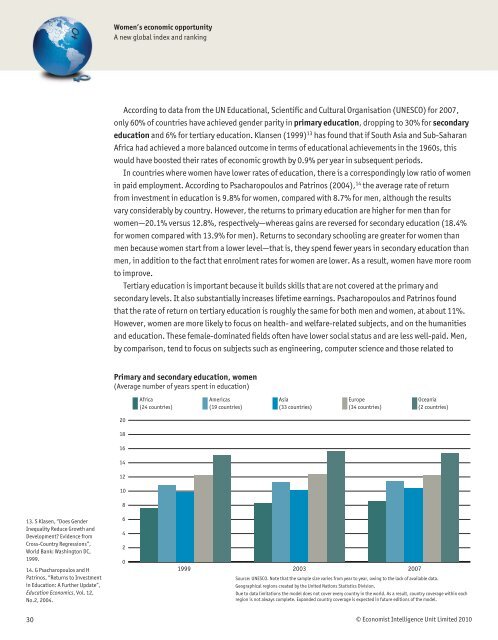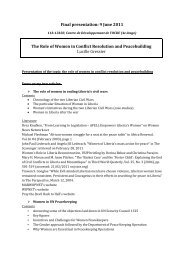Women's Economic Opportunity Index - Economist Intelligence Unit
Women's Economic Opportunity Index - Economist Intelligence Unit
Women's Economic Opportunity Index - Economist Intelligence Unit
- No tags were found...
Create successful ePaper yourself
Turn your PDF publications into a flip-book with our unique Google optimized e-Paper software.
Women’s economic opportunityA new global index and rankingAccording to data from the UN Educational, Scientific and Cultural Organisation (UNESCO) for 2007,only 60% of countries have achieved gender parity in primary education, dropping to 30% for secondaryeducation and 6% for tertiary education. Klansen (1999) 13 has found that if South Asia and Sub-SaharanAfrica had achieved a more balanced outcome in terms of educational achievements in the 1960s, thiswould have boosted their rates of economic growth by 0.9% per year in subsequent periods.In countries where women have lower rates of education, there is a correspondingly low ratio of womenin paid employment. According to Psacharopoulos and Patrinos (2004), 14 the average rate of returnfrom investment in education is 9.8% for women, compared with 8.7% for men, although the resultsvary considerably by country. However, the returns to primary education are higher for men than forwomen—20.1% versus 12.8%, respectively—whereas gains are reversed for secondary education (18.4%for women compared with 13.9% for men). Returns to secondary schooling are greater for women thanmen because women start from a lower level—that is, they spend fewer years in secondary education thanmen, in addition to the fact that enrolment rates for women are lower. As a result, women have more roomto improve.Tertiary education is important because it builds skills that are not covered at the primary andsecondary levels. It also substantially increases lifetime earnings. Psacharopoulos and Patrinos foundthat the rate of return on tertiary education is roughly the same for both men and women, at about 11%.However, women are more likely to focus on health- and welfare-related subjects, and on the humanitiesand education. These female-dominated fields often have lower social status and are less well-paid. Men,by comparison, tend to focus on subjects such as engineering, computer science and those related toPrimary and secondary education, women(Average number of years spent in education)Africa(24 countries)Americas(19 countries)Asia(33 countries)Europe(34 countries)Oceania(2 countries)20181614121013. S Klasen, “Does GenderInequality Reduce Growth andDevelopment? Evidence fromCross-Country Regressions”,World Bank: Washington DC,1999.14. G Psacharopoulos and HPatrinos, “Returns to Investmentin Education: A Further Update”,Education <strong>Economic</strong>s, Vol. 12,No.2, 2004.864201999 2003 2007Source: UNESCO. Note that the sample size varies from year to year, owing to the lack of available data.Geographical regions created by the <strong>Unit</strong>ed Nations Statistics Division.Due to data limitations the model does not cover every country in the world. As a result, country coverage within eachregion is not always complete. Expanded country coverage is expected in future editions of the model.30© <strong>Economist</strong> <strong>Intelligence</strong> <strong>Unit</strong> Limited 2010




